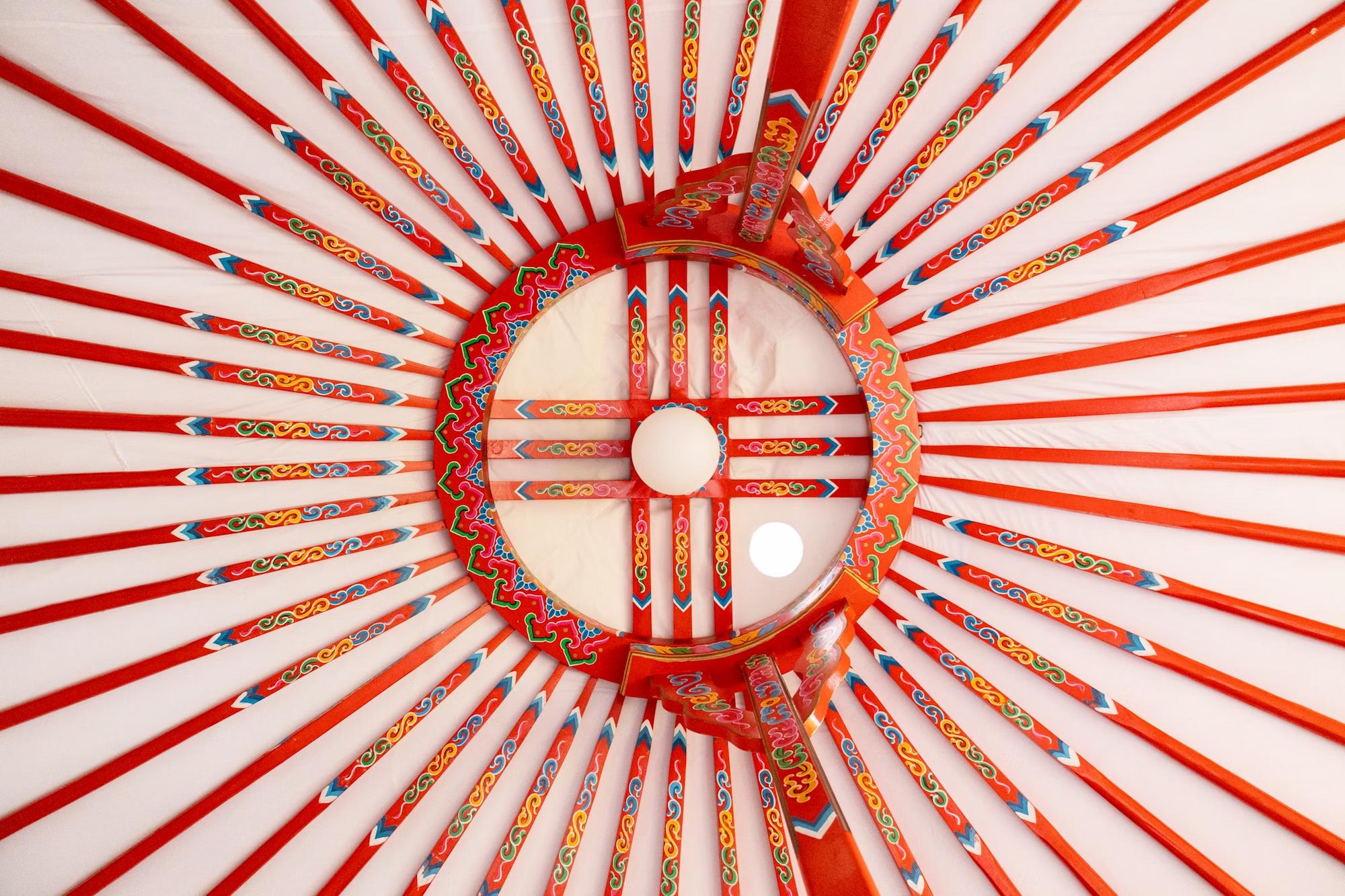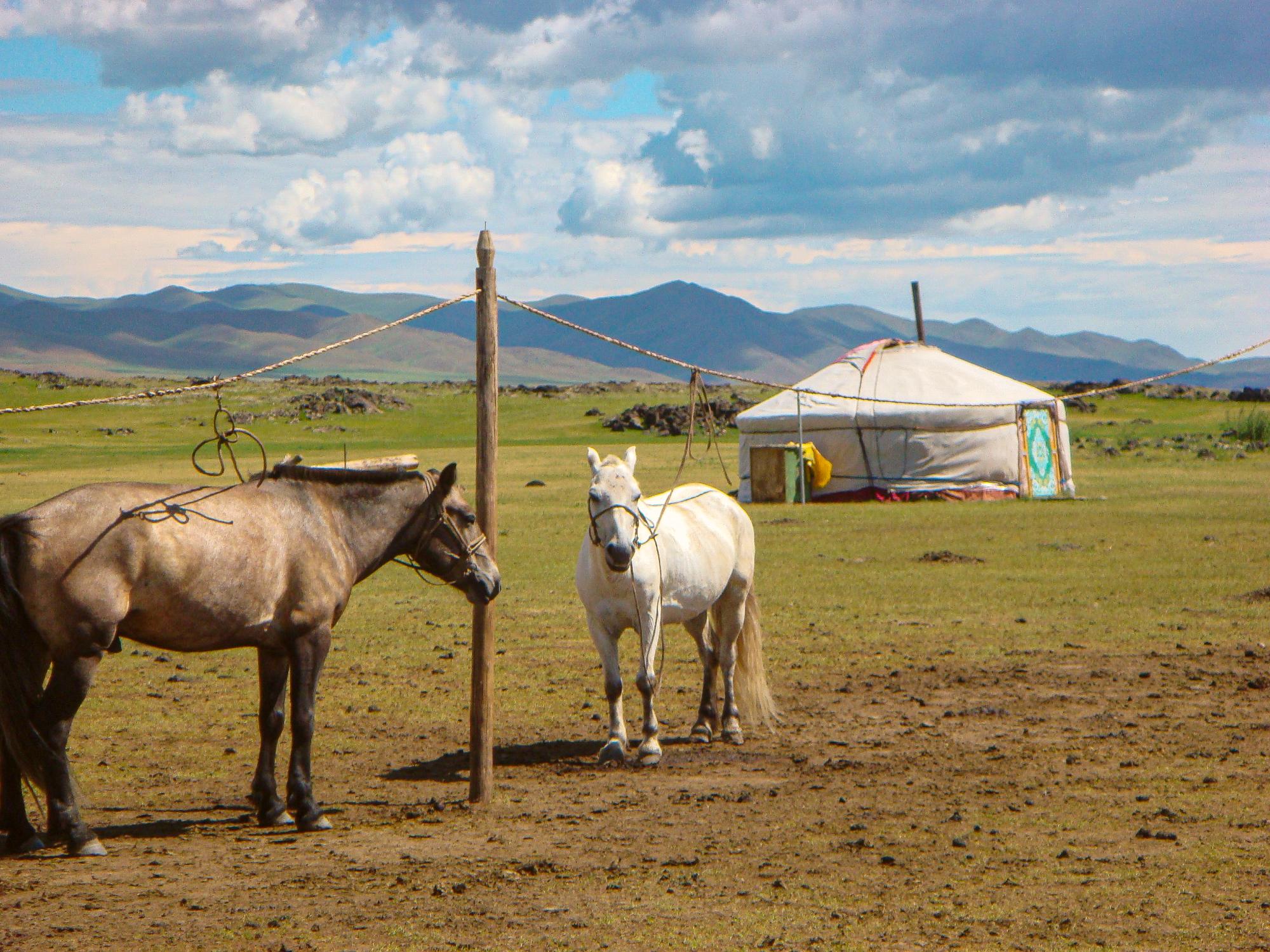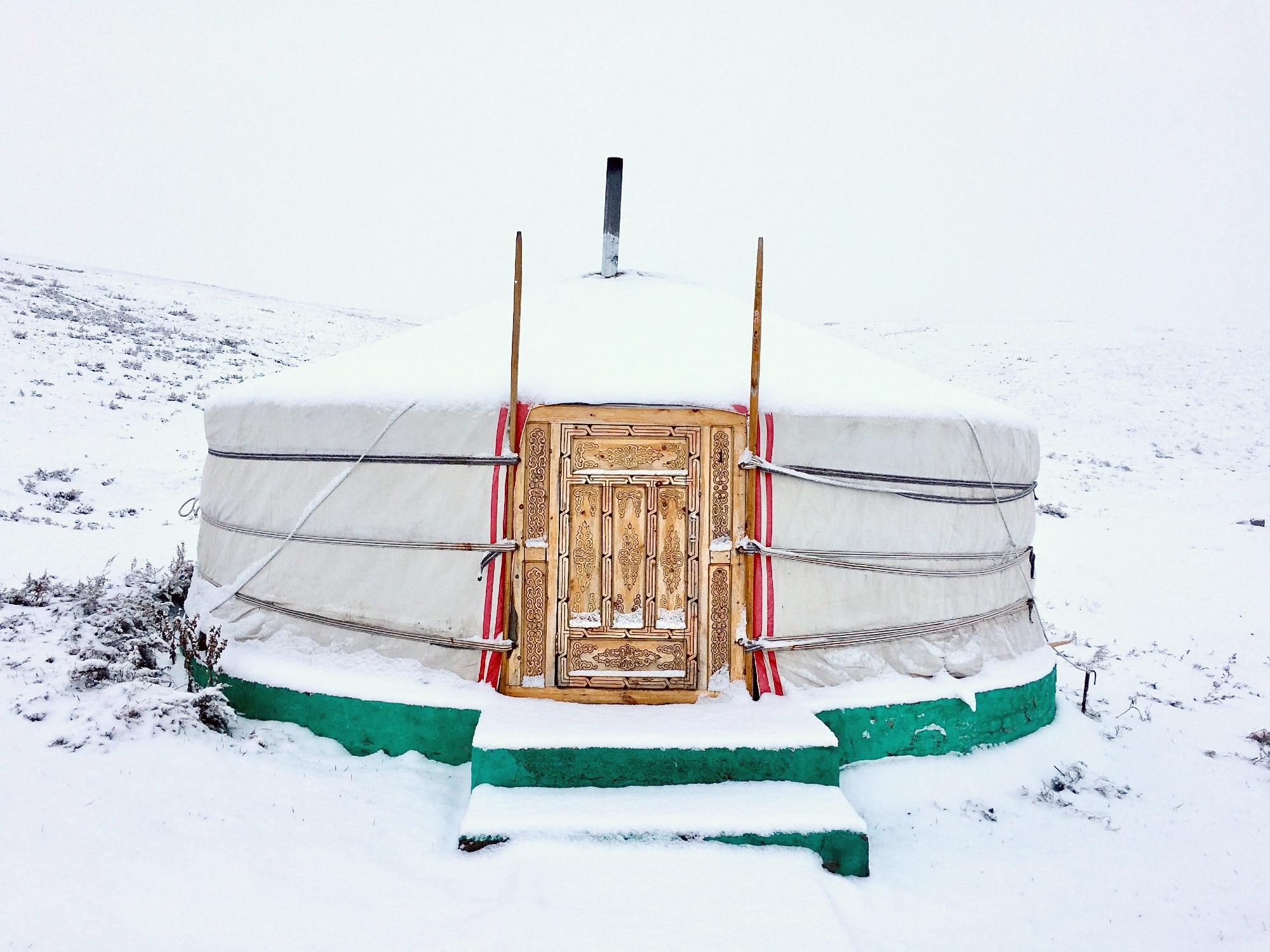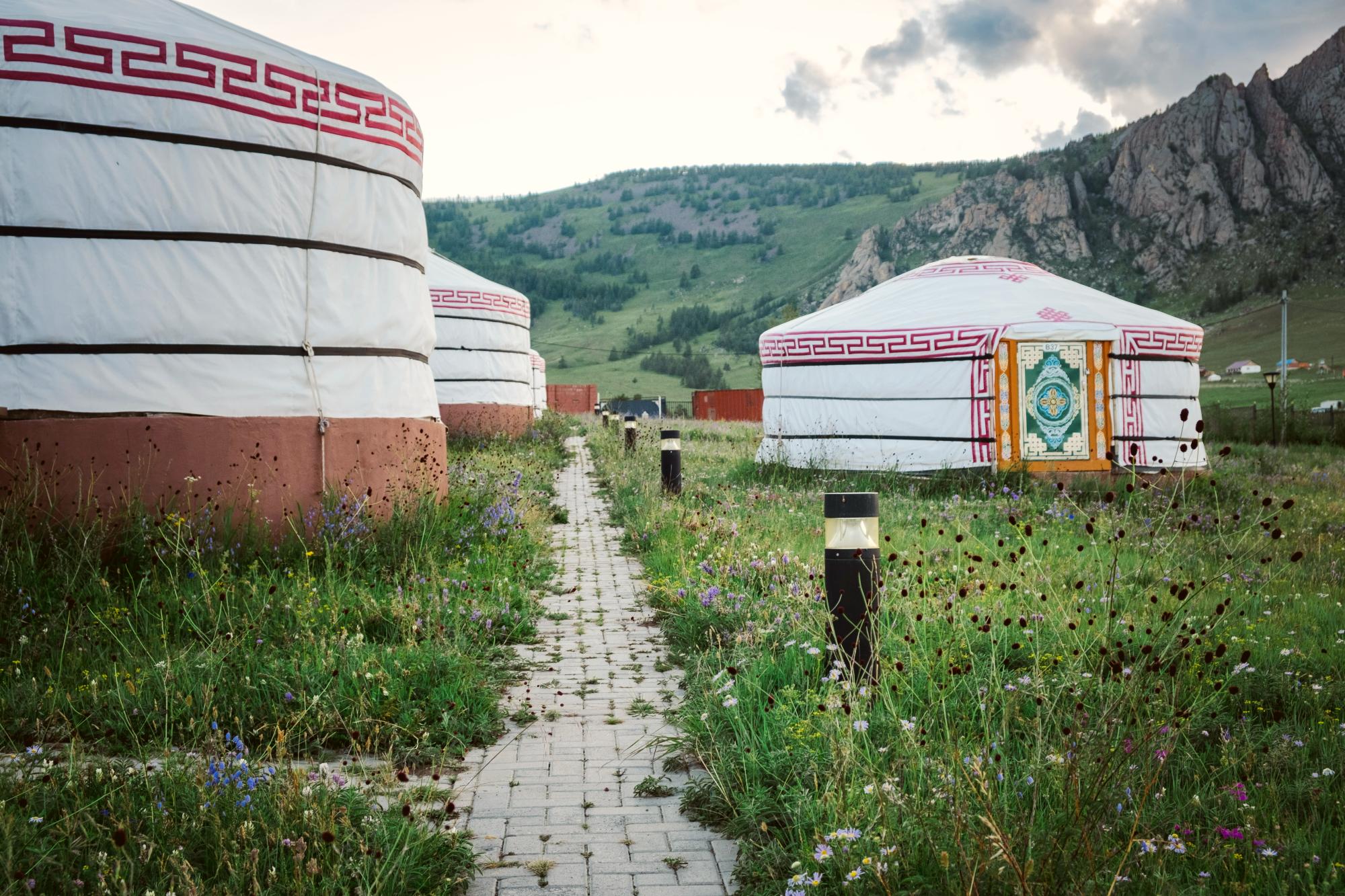Mongolian Yurt: Living Symbols of Culture, Sustainability, and Freedom
Contact us for travel suggestions
“A house is made of bricks and beams. A home is made of hopes and dreams.”
The Mongolian yurt, also known as a ger, is one of the most iconic and enduring examples of traditional portable dwellings. Its origins trace back over 3,000 years, with some estimates suggesting that the concept may have emerged as far back as 10,000 years ago across central asian cultures.
Similarly, the Kyrgyz yurt holds a unique cultural and historical significance in Central Asia, alongside the Mongolian yurt, highlighting the rich heritage and essential role it plays in the nomadic lifestyle.
The ger is not just a living space; it is a symbol of Mongolian resilience, embodying their connection to the natural world and their ability to thrive in some of the harshest environments on Earth.
More than just a dwelling, the traditional Mongolian yurts have played an instrumental role in Mongolian history. Its portability was a key factor in the success of the Mongol Empire, allowing Genghis Khan and his armies to maintain mobility and adaptability. This feature enabled them to conquer vast territories and effectively govern their growing empire. Today, the yurt remains a significant cultural symbol, representing the deep-rooted traditions of nomadic Mongolian society.
What is a Mongolian Yurt?
A Mongolian yurt, also known as a ger, is a traditional portable dwelling that has been used by nomadic people in Mongolia and Central Asia for centuries. This ingenious structure combines functionality, form, and deep cultural symbolism. Constructed by assembling a lattice framework of wooden slats, the yurt is then covered with layers of wool felt and canvas or other weather-resistant materials. The yurt’s distinctive dome-shaped roof, known as the toono, serves multiple purposes: it acts as a chimney for the stove, allows natural light to filter in, and symbolizes the connection between the earthly and heavenly realms. This design not only provides a comfortable living space but also reflects the nomadic lifestyle’s adaptability and resilience.
The Evolution of Yurt Design Over Millennia
The design of the Mongolian yurt has evolved over millennia, adapting to meet the needs of the nomadic lifestyles across central Asia while retaining its traditional essence. From early yurts that used basic wooden frames covered with animal hides to modern versions featuring felt insulation and lightweight wood, the yurt’s design has always reflected practicality and innovation.
In addition to Mongolian yurts, Turkic yurts are also prominent in Central Asia, showcasing different design variations and cultural significance. These yurts vary in materials and construction techniques, reflecting the diverse traditions of the region.
The construction techniques have also become more refined over the years. The use of bent wood for the roof poles (uni) and the creation of foldable lattice walls (khana) are innovations that have made yurts increasingly portable and efficient. Despite these advancements, the core principles of the yurt—portability, sustainability, and comfort—remain unchanged, proving the timelessness of this structure. Most central asian countries have their own variations of the Mongolian yurt.
The Design and Symbolism of the Mongolian Yurt

Ingenious Design: The Ger Built to Endure the Steppe
The Mongolian yurt is designed to withstand the extreme conditions of the Mongolian steppe, including cold winters and strong winds. The yurt's wooden frame, constructed from poles and lattice walls (khana), provides the structural strength necessary for the open plains while remaining lightweight and portable. The frame is covered with insulation, traditionally made from sheep wool, which helps maintain the internal temperature, keeping it warm during the winter and cool during the summer.
The circular shape of the yurt is not only functional but also deeply symbolic. Structurally, the round design provides excellent wind resistance, essential in the often gusty countryside. Symbolically, the yurt's circular form represents eternity, balance, and the interconnectedness of all life, echoing the Mongolian worldview.
The crown, or toono, is the circular opening at the top of the yurt's conical roof that connects the wooden poles (uni). It is a key feature that serves multiple functions: providing natural light, ventilation, and serving as a symbolic connection between the household and the eternal blue sky above—a concept deeply revered in Mongolian culture.
One of the defining characteristics of the Mongolian yurt is its portability. A yurt can be disassembled and reassembled in under an hour and a half, making it ideal for a nomadic lifestyle.
The size of a yurt is measured by the number of walls, with the standard yurt having four to five lattice walls, while larger yurts can be built to accommodate extended families or gatherings. The lattice wall count on large yurts can reach 12.
Symbolism Rooted in Tradition
The traditional yurt is rich in symbolism, and every component holds cultural significance. The pillars (bagana) that support the toono represent the husband and wife, symbolizing equality and partnership. These pillars are placed centrally, highlighting the balance of male and female roles within the household.
The stove, positioned directly between the two pillars, is considered the heart of the yurt. In Mongolian culture, fire is sacred, and the central stove provides not only warmth but also represents the soul of the family, offering sustenance and protection. The stovepipe extends out through the wooden frame of the toono.
The fire is treated with reverence and is believed to have purifying properties, making the stove both a practical and spiritual centerpiece.
The roof poles radiate from the toono in a manner that symbolizes the four cardinal directions and eight sub-directions, aligning with 12 hours of the day and the 12-year cycle used in the Mongolian calendar. The traditional orientation of yurts is to build them with their doors facing south. Nomadic Mongols used the sunlight to keep track of time. This reflects the nomadic way of life, which is intricately connected with the natural rhythms of the earth and sky.
The decorative elements within the yurt, including furniture and slats, are adorned with unbroken patterns that depict elements of nature, such as mountains, rivers, animals, and celestial bodies like the sun and moon. These patterns are symbolic of Mongolian shamanism and Buddhism, highlighting the connection between humanity, nature, and the spiritual realm.
Mongolians also worship fire, which they see as a symbol of life. The stove's fire is central to the household, treated with the utmost respect. It is considered to be the heart of the home, ensuring warmth and well-being during the harsh winters. It symbolizes the continuity of family life and plays a vital role in spiritual practices.
How Mongolian Yurts Have Shaped their Culture

Traditional yurts are more than a place to sleep—it is an expression of Mongolian culture and way of life. The layout of the yurt reflects social roles and spiritual beliefs that have been passed down through generations.
Inside the traditional yurts, the space is divided into specific areas with distinct purposes. The man’s side (west) is where tools, weapons, and items associated with male duties are kept. The woman’s side (east) contains cooking utensils, fabrics, and other items related to female responsibilities. The altar area, located opposite the doorway, is reserved for the most respected possessions, including religious artifacts, and serves as a place to seat honored guests.
When a young couple gets married, acquiring their own Mongolian ger is the first step toward establishing a new household. Traditionally, the husband's family provides the herd animals needed to support the couple, while the wife's family contributes all the household items necessary to set up the ger. This tradition underscores the importance of community, family support, and the balance of responsibilities within nomad culture.
Life inside a Mongolian yurt fosters independence and self-reliance. The need to build, maintain, and relocate the yurt has made Mongolians extremely independent. This independence has also contributed to a more individualistic culture compared to other Asian societies, which is one reason why democracy has found strong roots in Mongolia. Mongolians are inherently freedom-loving, and their cultural values align closely with the principles of democracy.
The Nomadic Lifestyle: Moving with Seasons
The nomadic lifestyle of Mongolian people is deeply tied to the yurt. Nomads move their yurts four times a year with the changing seasons to provide fresh pasture for their livestock. This mobility encourages a minimalist lifestyle focused on spiritual wealth and community rather than material possessions. Since space is limited, only essential items are carried, which emphasizes the value of relationships, the natural world, and the nomadic culture.
Hospitality is a cornerstone of Mongolian culture, and the yurt plays a central role in this tradition. Nomadic families readily welcome travelers, offering them food, drink, and shelter—sometimes without even knowing who they are. This tradition is rooted in necessity; in Mongolia's harsh climate and remote areas, survival often depends on mutual assistance. Guests are considered a blessing, and it is an honor for a family to host them.
Modern Uses and Adaptations of Mongolian Yurts
In recent years, modern yurts have gained popularity around the world, driven by the rise of the glamping movement and a growing interest in sustainable living.
The eco-friendly design and portability of the yurt make it a desirable option for those seeking a sustainable lifestyle or wanting to live off-grid.
When considering yurt pricing, potential buyers should be aware of the various factors that influence the cost of different yurt models. These factors include the design, materials, and additional features such as insulation, solar panels, and wood-burning stoves, which can cater to both traditional and luxurious options.
Modern adaptations of the traditional Mongolian yurt include features such as insulated walls, solar panels, and wood-burning stoves to make them suitable for year-round living. Yurts are now being used as eco-resort accommodations and luxury glamping experiences, offering guests an opportunity to connect with nature while still enjoying the comforts of modern amenities.
Interestingly, nomads have begun embracing Starlink technology for high-speed internet access, even in the most rural areas of Mongolia. This has transformed Mongolian nomads into digital nomads, allowing them to stay connected with the world while maintaining their traditional lifestyle. With Starlink, they can communicate with family, access information, and even run businesses online. This blend of ancient tradition and modern technology is helping the nomadic way of life to adapt and flourish in the 21st century.
Modern yurts have also become popular in the tiny homes movement. Its circular shape, use of natural materials, and cost-effective construction make it an appealing option for those looking to downsize and live more sustainably. Despite these modern adaptations, the core design of the Mongolian yurt remains unchanged, which is a testament to its enduring practicality and cultural importance.
The Role of Yurts in Mongolian History
The Mongolian gers have always been more than just a dwelling; it has been a symbol of strength, mobility, and adaptability. During the Mongol Empire, the yurt allowed Genghis Khan and his armies to travel vast distances while maintaining a sense of home. The mobility of the yurt was a crucial factor in the Mongols' ability to expand their empire from central Asia to across continents.
The practicality and comfort of the yurt meant that Mongol warriors could move across large areas without losing their connection to home. This contributed to the Mongols' incredible success in establishing one of the largest empires in history. Today, the yurt remains a powerful cultural symbol, representing the ingenuity of the Mongolian people and their deep connection to the land.
The Role of Mongolian Yurts in Spiritual Practices and Family Life

Authentic Mongolian yurts play a vital role in the spiritual practices of families. The central stove, with its sacred fire, is considered the soul of the household, symbolizing warmth, life, and the continuity of family traditions. Fire is treated with reverence, and certain customs are observed to maintain the purity of the flame.
The altar area in the yurt is another spiritual focal point. This space holds religious artifacts, family heirlooms, and offerings to deities and ancestors. It is a place where families come together to pray, perform rituals, and seek blessings.
The layout of the yurt itself is symbolic of the universe, with the toono representing the connection between the earthly realm and the sky, making it a space for worship and reflection.
Environmental Benefits and Sustainability of Mongolian Yurts
The Mongolian yurt is an excellent example of a traditional portable dwelling with sustainable architecture. Built primarily from natural materials like wood and sheep's wool, the yurt has a minimal environmental impact. The felt insulation, made from wool, is biodegradable and renewable, reducing reliance on synthetic materials that can be harmful to the environment. The circular design of the yurt also maximizes energy efficiency, with heat being evenly distributed throughout the space.
The portability of the yurt means that it leaves little to no permanent footprint on the landscape. Nomadic families move their yurts with the changing seasons, allowing the land to recover and minimizing overgrazing. This low-impact lifestyle of nomadic cultures is inherently sustainable, emphasizing harmony with nature and responsible land use.
In addition, the minimalist lifestyle encouraged by living in a yurt reduces consumption and waste. Nomads only carry essential items, which means less resource use and a smaller carbon footprint.
The yurt's reliance on renewable energy sources, such as solar power for lighting and wood-burning stoves for heating, further contributes to its environmental benefits, making it a model for eco-friendly living.
The Role of Yurts in Central Asian Cultures, Folklore, and Stories
The Mongolian ger is not only a practical dwelling but also a central figure in many folktales and legends. Stories often depict the yurt as a sacred space where important events unfold. For instance, it is said that the toono (the crown opening) serves as a gateway to the heavens, allowing the spirits of ancestors to watch over the family. This belief underscores the spiritual significance of the yurt in Mongolian culture.
In Mongolian folklore, the yurt is often portrayed as a living entity, imbued with the spirit of the family it shelters. The fire in the stove is believed to hold the spirit of the household, and disrespecting the fire is thought to bring bad luck. Many tales emphasize the importance of treating the yurt with respect, as it is seen as a guardian of the family’s well-being.
There are also stories about heroic figures who traveled vast distances with their yurts, showcasing the mobility and resilience of the nomadic lifestyle.
These tales often highlight the yurt's role in providing safety and comfort during long journeys across the harsh steppe, reinforcing its status as a symbol of Mongolian endurance and adaptability.
Mongolian Yurts Through the Seasons: Winter and Summer

The traditional yurt is designed to provide comfort throughout the year, regardless of the season. During the cold winters, the thick felt insulation and central stove provide warmth, creating a cozy environment even as temperatures drop well below freezing. The yurt is built to withstand the extreme cold and winds of the Mongolian winter, offering a welcoming space for families to gather.
In the dry summers, the yurt's construction help keep it cool, making it a comfortable retreat during the hot afternoons. The crown opening allows natural light to fill the yurt, creating a bright and cheerful atmosphere.
Summer is also the time for Naadam, Mongolia's national festival, which celebrates traditional sports like horse racing, archery, and wrestling. Staying in a yurt during Naadam provides a unique opportunity to experience Mongolian culture firsthand.
During the Mongolian winter, yurts transform into warm sanctuaries, with the stove providing essential heat and the felt insulation keeping out the cold.
The Khuvsgul Lake Ice Festival, held annually, is a popular winter event that showcases the resilience and creativity of the nomadic people. It is a reminder that Mongolians do not merely survive in harsh conditions; they thrive.
Durability and Lifespan of Mongolian Yurts
Mongolian yurts are renowned for their durability and long lifespan. When well-maintained, these traditional dwellings can last for many years, even decades. The longevity of a yurt largely depends on the quality of materials used, the craftsmanship involved, and the care it receives over time. Traditional Mongolian yurts are crafted from wood, wool, and canvas, which are inherently resistant to harsh weather conditions and can endure extreme temperatures. In contrast, modern yurts may incorporate more durable materials like metal framing and radiant insulation, further extending their lifespan. This blend of traditional and modern elements ensures that yurts remain a reliable and sustainable housing option.
Modern Amenities and Traditional Experiences in Mongolian yurts

The Mongolian yurt has evolved to meet the needs of modern travelers, offering both traditional experiences and modern comforts. Guests can now enjoy staying in a yurt with luxurious amenities such as solar-powered electricity, comfortable furnishings, and even Wi-Fi access. High-end camps and eco-resorts throughout the countryside provide a blend of traditional living and modern luxury.
For those seeking an authentic experience, staying with a nomadic family offers a unique glimpse into the nomadic lifestyle. The simplicity of life in a yurt, combined with the beauty of Mongolia's landscapes, provides a therapeutic retreat from the demands of modern society.
The experience of helping a nomadic family with daily tasks, enjoying home-cooked meals, and sleeping under a sky full of crystal-clear stars is deeply enriching and offers a connection to a way of life that has endured for thousands of years.
You Can Stay in a Mongolian Yurt
At Avis Mongolia, we offer self-drive and guided tours that allow you to experience staying in an authentic Mongolian yurt. Whether you're looking to immerse yourself in the nomadic way of life or enjoy a glamping experience with modern amenities, our tours are tailored to meet your preferences.
We also provide yurt camping experiences by using camping tent yurts manufactured by Ovoo. The tents uses modern materials instead of wooden parts.
Modern Mongolian tourist camps all feature yurts, providing guests with the opportunity to experience traditional living with added comforts, such as private bathrooms and modern facilities.
 A typical nomadic family with two gers.
A typical nomadic family with two gers.